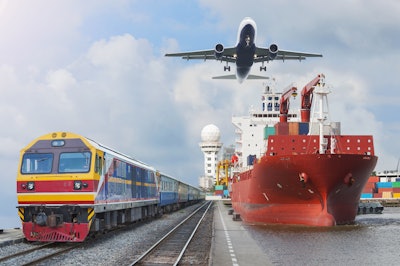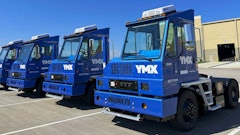
Come 2025, the global supply chain landscape faces significant transformations. Global shippers are dealing with challenges like changing ocean carrier alliances, new government administrations, possible port strikes, and geopolitical conflicts. These events have already strained supply chains, and the situation is expected to intensify as we enter the first quarter.
The most important factor in navigating ongoing disruptions and building resiliency into supply chains at a time when they are growing increasingly complex globally is to anticipate what is to come.
- Global trade changes
Tariffs are top of mind for many as 2024 brought many trade and tariff changes, and expect more in the coming months. This includes, for example, the recent 35.5% tariff on imported electric vehicles from China by the European Union. It’s likely more global trade changes are on the horizon with new incoming government leadership. For example, U.S. President-elect Donald Trump indicated that he plans to use tariffs during his presidency. And other country leaders have responded, which could start a cascade of trade changes across the globe, and therefore supply chain shifts.
Many shippers began diversifying several years ago after the pandemic highlighted the need for greater supply chain agility and are not starting at Square 1. In fact, looking specifically at the Trans-Pacific lane, Chinese imported goods from the United States have decreased 8% from 2017-2023. During that same time, other countries in Southeast Asia, Mexico, Canada, India, and even some European countries have increased almost equally across the board. It’s clear that shippers have already been shifting their supply chains to optimize their resilience and we expect that trend to continue.
Beyond near/reshoring or decoupling from China, shippers are also looking for diversification across modes, such as ocean to air, full-container-load (FCL) to less-than-container-load (LCL), and even shifts in inland strategies. During the recent U.S. port strike, shippers executed different inland strategies, such as transloading, to make up for any time lost while their freight was stuck at the port.
- Shifts in ocean carrier strategies
New ocean carrier alliances, which control 60% of the global container market, are bound to present a level of market disruption as seen during past alliance shifts. For example, the Gemini Cooperation, a partnership between Hapag-Lloyd and Maersk, is set to launch in February 2025, aiming to reduce the number of port callings between Asia and North Europe by half, therefore shortening transit time by several days. This means smaller ports may be eliminated entirely from the route. This shift would not only impact ocean freight schedules, but will also likely shift how freight flows inland. The Trans-Atlantic trade will also experience change with the Ocean Alliance—comprised of CMA CGM, COSCO/OOCL, and Evergreen—which removes capacity between North America and Europe.
Another example is the new Port of Chancay in Peru, which aims to reduce shipping times between LATAM and Asia 10-plus days by bypassing traditional routes through the United States. Even if you’re not shipping between Asia and Peru, it is important to know that this new route not only bypasses a major consumer country, but could also consequently shift rates and available capacity in other lanes.
- Labor strikes
Many countries, including Canada, United States, Brazil, Australia, Italy, and India, have experienced port, rail and/or customs strikes this year. The jump in labor strikes started in 2023, with a 280% year-over-year increase in activity. The trend continued in 2024 and isn’t expected to slow down. Shippers are already preparing for a potential second U.S. port strike come Jan. 15, should the International Longshoremen’s Association (ILA) and the United States Maritime Alliance (USMX) fail to finalize their Master Contract. Industries like automotive and pharmaceuticals are especially eager to create contingency plans since even a two-day strike could significantly disrupt operations due to their just-in-time inventory model.
- Front-loading
Potential strikes, pending tariffs, and the Lunar New Year holiday have prompted shippers to front-load freight. While front-loading has typically been done via ocean, some priority freight is shifting to air in anticipation of a potential second U.S. port strike.
This behavior isn't new — back in 2018, some shippers increased production and stockpiled freight before the U.S. Section 301 tariffs went into effect. The difference today is that front-loading is a common approach across a range of shippers. Keep an eye out as to how this enhanced focus on front-loading heading into 2025 may impact freight patterns as the year progresses.
- E-commerce boom
The ongoing shift of air capacity to support e-commerce activity exiting Asia continues to impact other lanes. Recently, rates spiked on the Trans-Atlantic route due to aircraft being reassigned to the Trans-Pacific for e-commerce shipments. This shift in capacity has led to increased rates and reduced capacity on smaller volume lanes, a trend expected to persist as e-commerce demand from Asia remains strong.
This industry will be one to watch as it continues to exert a significant influence on global air freight supply and demand. And as air forecasting becomes more difficult, it’s key to add flexibility into your strategy and evaluate what freight is urgent and needs to ship via air to not only mitigate risk but also capitalize on cost savings.
- Geopolitical events
Geopolitical conflicts around the globe continue to impact supply chains. Due to the war in Ukraine, the airspace over the region remains closed, and airlines have avoided Russian airspace, forcing carriers to take longer routes over the Middle East. Now, with increasing tensions in the Middle East, including the Palestine-Israel conflict and political changes in Syria, it is likely other routes will need to be adjusted. Additionally, the diversions from the Red Sea and Suez Canal, which began in October 2023, continue to significantly reduce space capacity, disrupt schedule reliability, and contribute to global port congestion.
Going forward
Going into 2025, diversification for supply chain agility remains crucial as it allows adaptability during the changing market conditions.
Sustainability, GenAI, and more will also have an impact. A disruption at sea or a port strike can cascade down to significantly impact trucking and rail.
Shippers have made significant progress in this area over the past few years, but there's still more work to be done. Customers are encouraged to build more agility and flexibility across their supply chain so they’re not tied to one trade lane, region, or mode. This is critical as disruptions clog up one area of the supply chain, companies can strategize and shift freight to keep it moving despite the challenges.
A healthy and responsible supply chain starts with understanding its interconnectedness. In the New Year, initiate conversations on these topics and ask questions about the tailwind effect. This will help you anticipate potential challenges and opportunities and determine the best strategy to protect your supply chain and business objectives.

















